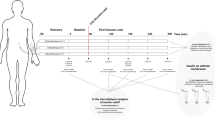Abstract
Interstitial fluid pressure (IFP), i.e., the pressure in a saline-filled tube brought into contact with the interstitium, has been measured in cats with two “acute” [micropipettes and wick-in-needle (WIN)] and two chronic (perforated and porous capsules) methods. In a control situation, similar pressures of −1.5 and −1.6 mm Hg were recorded in skin with micropipettes and both types of capsules, respectively, while WIN pressure in subcutis was −1.2 mm Hg. IFP in skeletal muscle was −0.5, −0.5, and −1.1 mm Hg as recorded with micropipettes, WIN, and porous capsules, respectively. During infusion of Ringer's solution, pressures in both types of capsules rose by 4 to 6 mm Hg, while pressure recorded with the acute methods increased by 1 to 1.5 mm Hg only. Two hours after infusion all techniques gave similar pressures. Peritoneal dialysis for 2 hours reduced micropipette and WIN pressures by 3 to 4 mm Hg. Pressure in perforated capsules fell by 10 mm Hg during dialysis and remained low for an additional 2 hours, while porous capsule pressure fell by 7 mm Hg during dialysis but thereafter increased and reached the pressure recorded with micropipettes and WIN 2 hours after ended dialysis. In both overhydration and dehydration, capsules probably react to changes in interstitial fluid colloid osmotic pressure; in overhydration the capsules react also to changes in capillary pressure, resulting in the discrepancy between chronic and acute methods during non-steady-state conditions. In conclusion, acute and chronic methods record similar pressures during steady-state conditions, but the chronic methods are sensitive to changes in vascular pressure and interstitial fluid colloid osmotic pressure and are therefore not suitable for measuring the changes that occur in IFP within a few hours.
Similar content being viewed by others
References
Aukland, K. and G. Nicolaysen. Interstitial fluid volume: Local regulatory mechanisms.Physiol. Rev. 61:556–643, 1981.
Blantz, R.C., A.H. Israelit, F.C. Rector, Jr., and D.W. Seldin. Relation of distal tubular naCl delivery and glomerular hydrostatic pressure.Kidney Int. 2:22–32, 1972.
Brace, R.A. Progress toward resolving the controversy of positive vs. negative interstitial fluid pressure.Circ. Res. 49:281–297, 1981.
Brace, R.A. and A.C. Guyton. Interaction of transcapillary Starling forces in the isolated dog forelimb.Am. J. Physiol. 233:H136-H140, 1977.
Chen, H.I., H.J. Granger, and A.E. Taylor. Interaction of capillary, interstitial, and lymphatic forces in the canine hindpaw.Circ. Res. 39:245–254, 1976.
Fadnes, H.O., R.K. Reed, and K. Aukland. Interstitial fluid pressure in rats measured with a modified wick technique.Microvasc. Res. 14:27–36, 1977.
Guyton, A.C. A concept of negative interstitial pressure based on pressures in implanted perforated capsules.Circ. Res. 12:399–413, 1963.
Guyton, A.C., H.J. Granger, and A.E. Taylor. Interstitial fluid pressure.Physiol. Rev. 51: 527–563, 1971.
Hargens, A.R., J.B. Cologne, F.J. Menninger, J.S. Hogan, B.J. Tucker, and R.M. Peters. Normal transcapillary pressures in human skeletal muscle and subcutaneous tissues.Microvasc. Res. 22: 177–189, 1981.
Hargens, A.R., S.J. Mubarak, C.A. Owen, L.P. Garetto, and W.H. Akeson. Interstitial fluid pressure in muscle and compartment syndromes in man.Microvasc. Res. 14:1–10, 1977.
Hopkinson, B.R., J.R. Border, W.C. Heyden, and W.G. Schenk, Jr. Interstitial fluid pressure changes during hemorrhage and blood replacement with and without hypotension.Surgery 64:68–74, 1968.
Intaglietta, M., R.F. Pawula, and W.R. Tompkins. Pressure measurements in the mammalian microvasculature.Microvasc. Res. 2:212–220, 1970.
Myers, R.R., H.C. Powell, M.L., Costello, P.W. Lampert, and B.W. Zweifach. Endoneurial fluid pressure: direct measurement with micropipettes.Brain Res. 148:510–515, 1978.
Noddeland, H., A.R. Hargens, R.K. Reed, and K. Aukland. Interstitial colloid osmotic and hydrostatic pressures in subcutaneous tissue of human thorax.Microvas. Res. 24:104–113, 1982.
Ott, C.E., J.-L. Cuche, and F.G. Knox. Measurement of renal interstitial fluid pressure with polyethylene matrix capsules.J. Appl. Physiol. 38:937–941, 1975.
Prather, J.W., D.N. Bowes, D.A. Warrell, and B.W. Zweifach. Comparison of capsule and wick techniques for measurement of interstitial fluid pressure.J. Appl. Physiol. 31:942–945, 1971.
Scholander, P.F., A.R. Hargens, and S.L. Miller. Negative pressure in the interstitial fluid of animals.Science 161:321–328, 1968.
Stromberg, D.D., and C.A. Wiederhielm. Effects of oncotic gradients and enzymes on negative pressures in implanted capsules.Am. J. Physiol. 219:928–932, 1970.
Wiederhielm, C.A. The tissue pressure controversy, a semantic dilemma. InTissue Fluid Pressure and Composition, edited by A.R. Hargens Baltimore/London: Williams & Wilkins, 1981, pp. 21–33.
Wiederhielm, C.A. and B.V. Weston. Microvascular, lymphatic, and tissue pressures in the unanesthetized mammal.Am. J. Physiol. 225:992–996, 1973.
Wiederhielm, C.A., J.W. Woodbury, S. Kirk, and R.F. Rushmer. Pulsatile pressures in the microcirculation of frog's mesentery.Am. J. Physiol. 207:173–176, 1964.
Wiig, H. and H. Noddeland. Interstitial fluid pressure in human skin measured by micropuncture and wick-in-needle.Scand. J. clin. Lab. Invest. 43:255–260, 1983.
Wiig, H. and R.K. Reed. Compliance of the interstitial space in rats. II Studies on skin.Acta Physiol. Scand. 113:307–315, 1981.
Wiig, H. and R.K. Reed. Rat brain interstitial fluid pressure measured with micropipettes.Am. J. Physiol. 244:H239-H246, 1983.
Wiig, H. and R.K. Reed. Interstitial compliance and transcapillary Starling pressures in cat skin and skeletal muscle.Am. J. Physiol. 248:H666-H673, 1985.
Wiig, H., R.K. Reed, and K. Aukland. Micropuncture measurement of interstitial fluid pressure in rat subcutis and skeletal muscle: Comparison to wick-in-needle technique.Microvasc. Res. 21:308–319, 1981.
Zelis, R., G. Lee, and D.T. Mason. Influence of experimental edema on metabolically determined blood flow.Circ. Res. 34:482–490, 1974.
Author information
Authors and Affiliations
Rights and permissions
About this article
Cite this article
Wiig, H., Reed, R.K. & Aukland, K. Measurement of interstitial fluid pressure: Comparison of methods. Ann Biomed Eng 14, 139–151 (1986). https://doi.org/10.1007/BF02584264
Issue Date:
DOI: https://doi.org/10.1007/BF02584264




